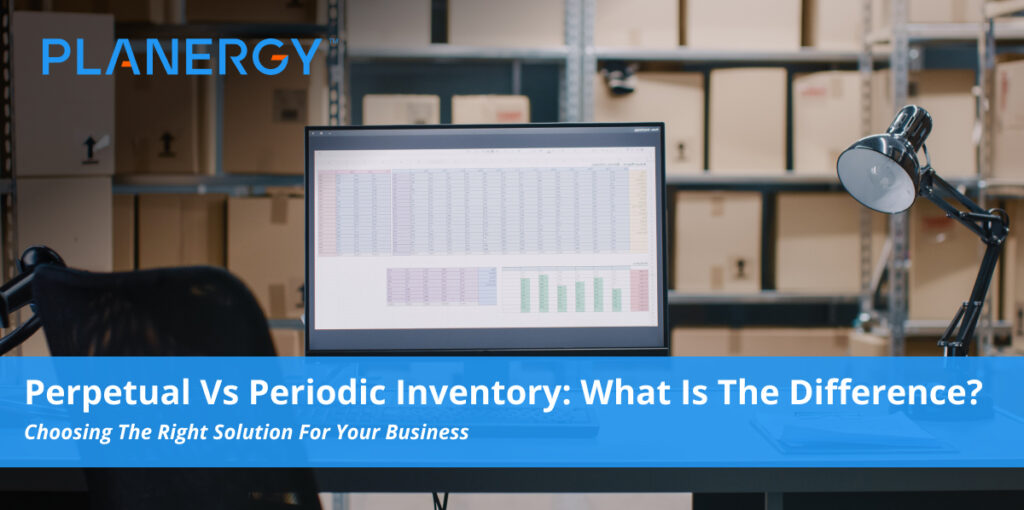From mega corporations to the smallest of small businesses, knowing what you have, what you need, and how well you’re balancing your expenses against your sales is part of running a successful business.
Every company with goods on hand needs to track them accurately and completely.
The two most common ways to manage inventory—perpetual inventory systems and periodic inventory systems—each have their own pros and cons, so it’s important to understand how they differ when deciding which is right for your business.
Perpetual vs Periodic Inventory Systems: The Basics
Tracking inventory effectively requires awareness of what you have on hand (inventory balance) and the cost of goods sold (COGS).
Both perpetual inventory systems and periodic inventory systems allow you to monitor inventory and calculate COGS.
For both systems, COGS (which essentially tracks a company’s gross margin) is calculated as follows.
(Beginning Inventory Balance + Cost of Inventory Purchases) – Ending Inventory Cost = COGS
Perpetual Inventory Systems
The more modern of the two inventory management options, perpetual systems provide real-time updates on inventory levels.
Every time goods are received or sold, the system automatically records the change in the inventory account.
Purchases are automatically recorded, either in the raw materials inventory account or the merchandise account, depending on the type of items purchased.
As a result, the inventory account balance is always up to date, barring unrecorded changes due to theft or damaged goods.
Real-time inventory counts, supported by the use of digital tools (e.g., inventory management software), make it easier to calculate COGS and update the cost of goods sold account.
It also allows you to integrate your inventory management with the rest of your business processes automation strategy, providing efficiency improvements in procurement, accounting, and beyond.
Researching and implementing inventory management as part of a large-scale business process improvement initiative (e.g., digitizing your purchasing and accounts payable functions through a transition to a centralized, cloud-based procurement software solution) have a certain price tag attached.
However, such an investment yields tangible benefits almost immediately in the form of process improvements and data transparency.
Periodic Inventory Systems
In this systems, inventory records and COGS rely on a physical inventory count. Purchases are recorded in the purchases account, and both the inventory account and the cost of goods sold account are updated at the end of a specific period.
The interval varies by system and company, but the end of the accounting period could be month-to-month, quarterly, or even once a year.
Depending on the size of the business, using a periodic inventory system can be a hard road to travel.
With hundreds, or even thousands, of items to track and count, the idea of performing a physical inventory count every week, let alone daily or on demand, is improbable at the least.
In addition, the potentially long gaps between physical counts can make it extremely difficult to get clear, accurate, and complete inventory levels.
As a result, expenses that are reduced by implementing a perpetual inventory system can instead increase in a periodic inventory system.
Difficulties with inventory tracking, inventory turnover calculations, and stock loss can lead to costly inaccuracies in your inventory ledger.
Inaccurate inventory counts can lead to crucial raw materials running short for production, as well as delays and loss of goodwill from disappointed customers.
Finally, inaccurate calculations that make it into your bookkeeping system can create unforeseen expenses due to extra staff hours spent chasing and correcting errors, and cause even larger headaches during reporting, forecasting, and audits.
In the past, it was taken as read that small business owners, lacking the resources or need for enterprise-level digital transformation, would opt for a periodic inventory system by default, and then invest in a technology-centric perpetual inventory system as growth and budget allowed. But choosing between a perpetual inventory system and a periodic inventory system is about much more than cost.
Which Inventory Management System is Best for Your Business?
In the past, it was taken as read that small business owners, lacking the resources or need for enterprise-level digital transformation, would opt for a periodic inventory system by default, and then invest in a technology-centric perpetual inventory system as growth and budget allowed.
But choosing between a perpetual inventory system and a periodic inventory system is about much more than cost.
However, the inventory management modules included with many modern procurement solutions—as well as stand-alone inventory control solutions that can be customized for each company’s specific needs—have become increasingly scalable, and therefore affordable and practical, for organizations of all sizes.
PLANERGY, for example, can be purpose-built, allowing users to start off select modules to achieve their most important process improvement goals (e.g., more accurate inventory management) while still allowing room for additional expansion as needed, without requiring further disruptions to the software environment.
On the other hand, not every business is ready to make the investment, cultural changes, and procedural revisions necessary to make the digital leap.
For many small businesses—particularly those with low sales volume and modest inventories, e.g. car dealerships, artisans, etc.—a periodic solution makes good sense, since inventory counts won’t be as onerous as they might be for, say, a parts distributor.
Periodic inventory can also be a smart choice for small businesses with a large inventory of moderately priced items and a high sales rate.
Small grocers, single-location clothing stores, and non-chain-based convenience stores all rely on, and offer, a large number of both incoming materials and outgoing goods.
Periodic inventory works for these small businesses because:
- They make a high volume of sales with a very wide array of moderately priced goods, but don’t have the logistics challenges of multiple locations or manufacturing.
- Often deal with daily inventory changes due to write-offs, returns, and stockloss.
- Place an emphasis on efficiency and labor savings to achieve their sometimes tight margins, and physical inventory counts represent a significant amount of time and labor.
Companies with huge inventories (such as bulk resellers, discount giants such as Wal-Mart, etc.) may combine advanced inventory tracking via a software solution with physical stock-taking to create a system that provides a general idea of available inventory during the financial year with firm physical counts at the end of the period (whether it’s monthly, quarterly, yearly, etc.).
So while the barcode on a can of peas (for example) ensures the sale will be automatically recorded in the inventory and accounting systems, the company will still conduct a physical count yearly to get a concrete grasp of enterprise-wide stock loss, potential process inefficiencies, and other inventory issues.
For these companies, periodic inventory counts provide guidance and insights that allow for further process refinements (and, as needed, detailed inventory audits), while the perpetual inventory management component gives them transparency and the option to “dive into” inventory controls to address any issues that occur while keeping labor and time commitments to a minimum.
Ultimately, while the perpetual the best inventory management system for your business is one that suits your specific needs.
Consider these pros and cons:
TYPE OF SYSTEM | PROS | CONS |
| Perpetual Inventory Systems |
|
|
| Periodic Inventory Systems |
|
|
Is Your Inventory Management System Up to Snuff?
Big or small, your business can’t operate at peak performance without accurate and transparent inventory controls.
If your current inventory management system isn’t cutting the mustard (or, worse yet, can’t find the mustard), it may be time to consider making the switch to a more robust, real-time solution.
The improvements you make today will help support your company’s efficiency, growth, and competitive performance well into the future.




